News
|
|
 St Barnabas Cathedral, Nottingham
St Barnabas Cathedral, Nottingham photo: Joe Martin
Major restoration of St Barnabas, Nottingham
by Joanna Lyall, June 26, 2024
A major restoration project has been launched at St Barnabas, Nottingham’s Catholic cathedral, backed by the Heritage Lottery Fund.
Designed by AWN Pugin St Barnabas was completed in 1844, at a cost of £20,000, of which £7,000 was provided by the Earl of Shrewsbury. Pugin envisaged it would be “the richest thing attempted … three times the solemnity of St George’s …- or Birmingham” Now grade-II* listed the building has undergone several redecorations, and in 1962 a major reordering which included white overpainting. Nikolaus Pevsner in Nottinghamshire (The Buildings of England) said: “The whole effect could hardly be further from the richness and decorative atmosphere that Pugin intended.”
In September 2022 the cathedral was awarded £277,558 from the Heritage Lottery Fund to restore some of Pugin’s design work at the East end of the cathedral. A further delivery grant of £524,858 is expected.
Restoring Pugin is led by the cathedral in partnership with Nottingham Trent University and Culture Syndicated CIC, a Nottingham community enterprise aimed at helping young people start careers in heritage. The project is now in an initial 12-month research phase and it is envisaged that Pugin’s decoration will be restored to the east end in 2025.
Project manager, Jane Hellings said: “Our conservators have completed six months of meticulous work on 60 ‘windows’ or squares. scraping away layers of paint. It has uncovered many of the original designs by Pugin.”
The restoration comprises: St Hugh’s chapel, the Unity chapel and the Lady chapel and ambulatories in the east of the cathedral.
by Joanna Lyall, June 26, 2024
A major restoration project has been launched at St Barnabas, Nottingham’s Catholic cathedral, backed by the Heritage Lottery Fund.
Designed by AWN Pugin St Barnabas was completed in 1844, at a cost of £20,000, of which £7,000 was provided by the Earl of Shrewsbury. Pugin envisaged it would be “the richest thing attempted … three times the solemnity of St George’s …- or Birmingham” Now grade-II* listed the building has undergone several redecorations, and in 1962 a major reordering which included white overpainting. Nikolaus Pevsner in Nottinghamshire (The Buildings of England) said: “The whole effect could hardly be further from the richness and decorative atmosphere that Pugin intended.”
In September 2022 the cathedral was awarded £277,558 from the Heritage Lottery Fund to restore some of Pugin’s design work at the East end of the cathedral. A further delivery grant of £524,858 is expected.
Restoring Pugin is led by the cathedral in partnership with Nottingham Trent University and Culture Syndicated CIC, a Nottingham community enterprise aimed at helping young people start careers in heritage. The project is now in an initial 12-month research phase and it is envisaged that Pugin’s decoration will be restored to the east end in 2025.
Project manager, Jane Hellings said: “Our conservators have completed six months of meticulous work on 60 ‘windows’ or squares. scraping away layers of paint. It has uncovered many of the original designs by Pugin.”
The restoration comprises: St Hugh’s chapel, the Unity chapel and the Lady chapel and ambulatories in the east of the cathedral.
 Blassed sacrament chapel with Puginesque decoration
Blassed sacrament chapel with Puginesque decoration by Elphege Pippet c1934
photo: Joe Martin
Nottingham Trent University has placed 12 sensors round the cathedral to monitor damp and humidity across the year. There is a problem of damp rising at the bases of columns and it is hoped to find a solution to this problem before the start of the paint restoration. Nottingham Civic Society has given £15,000 towards the repair of the roofs in the East End chapels.
Dean of the cathedral, Malachy Brett, who trained for the priesthood at Oscott seminary, Birmingham, where AWN Pugin taught as Professor of Ecclesiastical Antiquities, said he was delighted with the restoration project. “`Not only will we be able to restore some of Pugin’s magnificent original design work to the Cathedral but also create opportunities for young people to engage in heritage and conservation work.”
The Cliveden Conservation team includes two trainee paint conservators: Mary Scott, a recent graduate of the MA Conservation of Fine Art at Northumbria University and Emily Bird, who studied for an MA in Conservation of Cultural Heritage at the University of Lincoln.
At a study day on the project, held at the cathedral on June 1, Ana Longreira, senior conservator with Cliveden Conservation, said six layers of paint had been removed to discover Pugin’s original decorative scheme. The materials and varnishes used in each layer had been recorded, she said. Ana previously worked on conservation of Pugin’s Drummond Chapel in the church of St Peter and St Paul, Albury, Surrey.
Nottingham Trent University’s department of Architecture, Built Environment and Planning is developing a digital game aimed at making 12-17 year olds aware of environmental issues in the Cathedral, such as temperature, humidity and air pollution.
The consecration ceremony for the cathedral in August 1844 was attended by 15 bishops and 100 priests and the Illustrated London News described the building as “the largest Catholic Church completed in this country since the reformation”
St Barnabas was where author Graham Greene was received into the Catholic faith in February 1926. Aged 21 and newly down from Oxford University, he was working as unpaid sub-editor on The Nottingham Journal.
Dean of the cathedral, Malachy Brett, who trained for the priesthood at Oscott seminary, Birmingham, where AWN Pugin taught as Professor of Ecclesiastical Antiquities, said he was delighted with the restoration project. “`Not only will we be able to restore some of Pugin’s magnificent original design work to the Cathedral but also create opportunities for young people to engage in heritage and conservation work.”
The Cliveden Conservation team includes two trainee paint conservators: Mary Scott, a recent graduate of the MA Conservation of Fine Art at Northumbria University and Emily Bird, who studied for an MA in Conservation of Cultural Heritage at the University of Lincoln.
At a study day on the project, held at the cathedral on June 1, Ana Longreira, senior conservator with Cliveden Conservation, said six layers of paint had been removed to discover Pugin’s original decorative scheme. The materials and varnishes used in each layer had been recorded, she said. Ana previously worked on conservation of Pugin’s Drummond Chapel in the church of St Peter and St Paul, Albury, Surrey.
Nottingham Trent University’s department of Architecture, Built Environment and Planning is developing a digital game aimed at making 12-17 year olds aware of environmental issues in the Cathedral, such as temperature, humidity and air pollution.
The consecration ceremony for the cathedral in August 1844 was attended by 15 bishops and 100 priests and the Illustrated London News described the building as “the largest Catholic Church completed in this country since the reformation”
St Barnabas was where author Graham Greene was received into the Catholic faith in February 1926. Aged 21 and newly down from Oxford University, he was working as unpaid sub-editor on The Nottingham Journal.
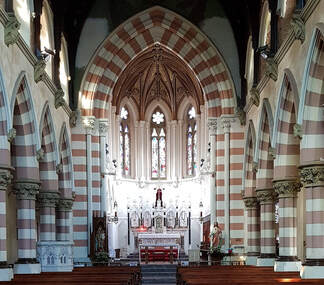 The interior or Edward Pugin's All Saints.
The interior or Edward Pugin's All Saints. Photo by Gerard Hyland.
Greyfriars set to leave EW Pugin's All Saints
The Pugin Society is concerned to learn that the Greyfriars are set to leave Edward Pugin's All Saints, Barton-upon-Irwell, Manchester, in the autumn. An article published in The Tablet on 23 April describes how the Greyfriars “are in discussion with a Catholic group to take over the Grade I listed church.” They have not disclosed the name of the group but insist “the church will be properly cared for.”
The Greyfriars’ decision to vacate the Gothic Revival church was prompted by staffing difficulties. Major developments in the church’s surroundings have transformed its once rural setting into one of industry and housing, which may have further contributed to this decision.
The Pugin Society is concerned to learn that the Greyfriars are set to leave Edward Pugin's All Saints, Barton-upon-Irwell, Manchester, in the autumn. An article published in The Tablet on 23 April describes how the Greyfriars “are in discussion with a Catholic group to take over the Grade I listed church.” They have not disclosed the name of the group but insist “the church will be properly cared for.”
The Greyfriars’ decision to vacate the Gothic Revival church was prompted by staffing difficulties. Major developments in the church’s surroundings have transformed its once rural setting into one of industry and housing, which may have further contributed to this decision.
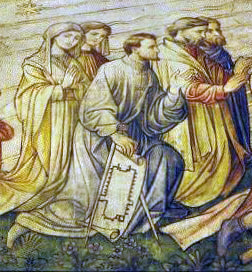 E W Pugin holding a plan of All Saints.
E W Pugin holding a plan of All Saints. Photo by Gerard Hyland.
The church was built by Edward Pugin between 1865-68 through the beneficence of Sir Humphrey de Trafford and contains that family’s chantry chapel. In addition to its striking architecture, it features a mural by J A Pippet in the chancel, depicting Edward Pugin himself, holding a plan of the locale. The Pugin Society visited this magnificent church in 1999 and we hope that it will be maintained to a high standard with an understanding of its architectural and cultural significance. The full article from The Tablet may be read HERE.

Pugin Week 2023 Events Announced
We are pleased to announce a week of outstanding Pugin-related events for 2023. In addition to Thanet's Heritage Open Days, there are events at St Augustine's Church, a sketching day, and several lectures including Dr Jasmine Allen's talk about Pugin's stained glass and the Great Exhibition. Head to our EVENTS page for a full schedule.
We are pleased to announce a week of outstanding Pugin-related events for 2023. In addition to Thanet's Heritage Open Days, there are events at St Augustine's Church, a sketching day, and several lectures including Dr Jasmine Allen's talk about Pugin's stained glass and the Great Exhibition. Head to our EVENTS page for a full schedule.
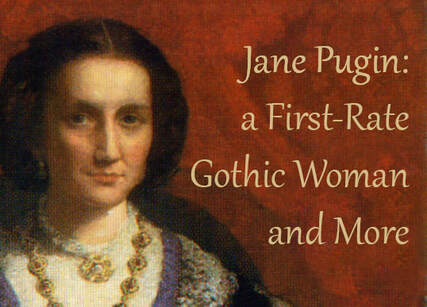
Catriona Blaker to present research on Jane Pugin
Founding society member and Pugin expert Catriona Blaker will present a talk 'Jane Pugin: a First-Rate Gothic Woman and More' on Thursday 21 September at San Clu Hotel, Victoria Parade, Ramsgate. Falling just outside Pugin Week, the presentation is part of the Ramsgate History Working Group's '23 for 23', celebrating twenty-three leading Ramsgate women, past and present, in the year 2023. The handsome and dignified Jane Pugin was long lived, and although married to Pugin in 1848 did not die until 1909, thus experiencing a whole series of changes and attitudes in Ramsgate and elsewhere. How this resourceful woman coped, and how she occupied her time, will be the subject of this talk. Free to Ramsgate Society members / £3 voluntary donation requested from others. Booking in advance essential. Click HERE to reserve your place. Doors open at 6:30, talk at 7.
Founding society member and Pugin expert Catriona Blaker will present a talk 'Jane Pugin: a First-Rate Gothic Woman and More' on Thursday 21 September at San Clu Hotel, Victoria Parade, Ramsgate. Falling just outside Pugin Week, the presentation is part of the Ramsgate History Working Group's '23 for 23', celebrating twenty-three leading Ramsgate women, past and present, in the year 2023. The handsome and dignified Jane Pugin was long lived, and although married to Pugin in 1848 did not die until 1909, thus experiencing a whole series of changes and attitudes in Ramsgate and elsewhere. How this resourceful woman coped, and how she occupied her time, will be the subject of this talk. Free to Ramsgate Society members / £3 voluntary donation requested from others. Booking in advance essential. Click HERE to reserve your place. Doors open at 6:30, talk at 7.
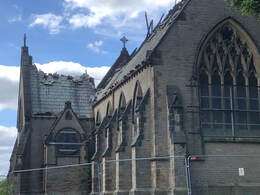 Photo by Mike Galloway
Photo by Mike Galloway
Fire at EW Pugin's Junior House and its Chapel
Members of the Committee of the Pugin Society were saddened to learn of the suspected arson attack that has gutted the Junior House and its chapel of St. Aloysius at Ushaw Historic House. While the outlook for the building looks bleak, we hope that some of the important artefacts (such as Karl Hoffmann’s statue of Our Lady, Mother of Jesus) and other architectural items can be rescued.
Members of the Committee of the Pugin Society were saddened to learn of the suspected arson attack that has gutted the Junior House and its chapel of St. Aloysius at Ushaw Historic House. While the outlook for the building looks bleak, we hope that some of the important artefacts (such as Karl Hoffmann’s statue of Our Lady, Mother of Jesus) and other architectural items can be rescued.
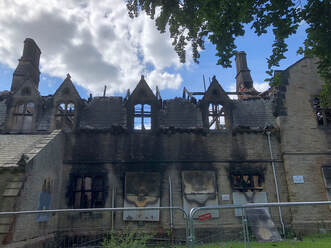 Photo by Mike Galloway
Photo by Mike Galloway
Junior House (including its chapel) was the ‘jewel in the crown’ of EW Pugin’s many works at Ushaw, and is the largest and most coherent complex of buildings designed by him, not only at Ushaw but anywhere; the site covers 36,000sq ft. At the age of only 22 years, EW Pugin won the commission in a limited competition in 1856 with JA and CF Hansom, who had already designed the library at Ushaw. Junior House was built between 1857 and 1859. The Tablet of 1 October 1860 described Junior House and its chapel (which is listed as Grade II*) as '…undoubtedly the most complete ecclesiastical institution we possess.'
Junior House was a totally self-contained, preparatory boarding school for boys aged between 7 and 14 years, when they moved next door the St Cuthbert’s College to continue their studies, some training for the priesthood. After functioning for 114 years, it closed in 1973, after which it became victim of repeated acts of vandalism, and was in an advanced state of dereliction even before the fire. A scheme for its restoration had been prepared, but had failed to attract the necessary funding.
EW Pugin’s other buildings at Ushaw, as well as those by other Pugin family members (AWN Pugin, his youngest son, Peter Paul, and a grandson Sebastian Pugin Powell), and by the Hansom brothers, are thankfully still intact and can be visited.
For 203 years, until its closure in 2011, St Cuthbert’s College at Ushaw served as a seminary, training men (mainly from the north of England) for the Catholic priesthood. In 2015, the Ushaw site re-opened as a Visitor Attraction (Ushaw: Historic House, Chapels and Gardens)¸ now drawing over 100,000 visitors a year. Read more about Pugin's work at Ushaw HERE.
Junior House was a totally self-contained, preparatory boarding school for boys aged between 7 and 14 years, when they moved next door the St Cuthbert’s College to continue their studies, some training for the priesthood. After functioning for 114 years, it closed in 1973, after which it became victim of repeated acts of vandalism, and was in an advanced state of dereliction even before the fire. A scheme for its restoration had been prepared, but had failed to attract the necessary funding.
EW Pugin’s other buildings at Ushaw, as well as those by other Pugin family members (AWN Pugin, his youngest son, Peter Paul, and a grandson Sebastian Pugin Powell), and by the Hansom brothers, are thankfully still intact and can be visited.
For 203 years, until its closure in 2011, St Cuthbert’s College at Ushaw served as a seminary, training men (mainly from the north of England) for the Catholic priesthood. In 2015, the Ushaw site re-opened as a Visitor Attraction (Ushaw: Historic House, Chapels and Gardens)¸ now drawing over 100,000 visitors a year. Read more about Pugin's work at Ushaw HERE.
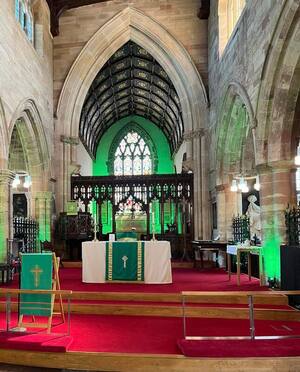
Open Days at St Oswald's Church, Winwick
St Oswald’s Church Winwick, Warrington dates from the early 13th century although it was mentioned as early as 1086 in the Domesday Book. Additions were made over the years and from 1847-49 the 13th Earl of Derby enlisted Pugin to rebuild the chancel, sanctuary, and vestry.
The church’s open days are an excellent opportunity to visit and view Pugin’s contribution to the fabric of this historic building. During their Open Weekend the chancel, along with the remaining parts of the church, will be open to the public at no cost. This is to fulfil the requirements of the Heritage Lottery fund which provided the church with £1.3 million to renovate the nave and side aisles roofs following an infestation of death watch beetle. Visit St Oswald’s website and facebook page for more details.
St Oswald’s Church Winwick, Warrington dates from the early 13th century although it was mentioned as early as 1086 in the Domesday Book. Additions were made over the years and from 1847-49 the 13th Earl of Derby enlisted Pugin to rebuild the chancel, sanctuary, and vestry.
The church’s open days are an excellent opportunity to visit and view Pugin’s contribution to the fabric of this historic building. During their Open Weekend the chancel, along with the remaining parts of the church, will be open to the public at no cost. This is to fulfil the requirements of the Heritage Lottery fund which provided the church with £1.3 million to renovate the nave and side aisles roofs following an infestation of death watch beetle. Visit St Oswald’s website and facebook page for more details.
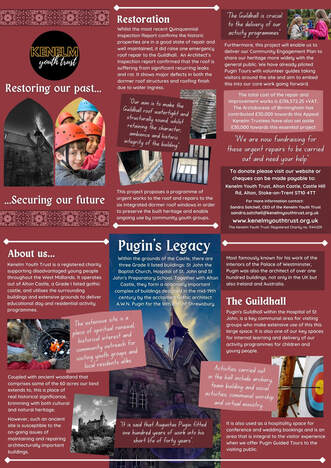
News from Alton Castle, Staffordshire
Designed by Pugin for his patron Lord Shewsbury, Alton Castle and its surrounding buildings (St John the Baptist Church, the Hospital of St John, and St John's Preparatory School) form a nationally important complex of Gothic revival buildings in Staffordshire. The Kenelm Youth Trust, a registered charity supporting disadvantaged youth throughout the West Midlands, currently oversee the properties and are aware of their cultural importance. Keen to maintain them and aware of the ongoing issues of maintaining and repairing these architecturally important buildings, they are fundraising for a £136,572 project to fix leaks and rot in the roof of the Guildhall. Looking forward, the group envision a larger Community Engagement Plan with Pugin Tours and related activites. To learn more and help preserve the built heritage of these Pugin sites in Staffordshire, visit the Kenelm Youth Trust HERE and view the leaflet on the right.
Designed by Pugin for his patron Lord Shewsbury, Alton Castle and its surrounding buildings (St John the Baptist Church, the Hospital of St John, and St John's Preparatory School) form a nationally important complex of Gothic revival buildings in Staffordshire. The Kenelm Youth Trust, a registered charity supporting disadvantaged youth throughout the West Midlands, currently oversee the properties and are aware of their cultural importance. Keen to maintain them and aware of the ongoing issues of maintaining and repairing these architecturally important buildings, they are fundraising for a £136,572 project to fix leaks and rot in the roof of the Guildhall. Looking forward, the group envision a larger Community Engagement Plan with Pugin Tours and related activites. To learn more and help preserve the built heritage of these Pugin sites in Staffordshire, visit the Kenelm Youth Trust HERE and view the leaflet on the right.
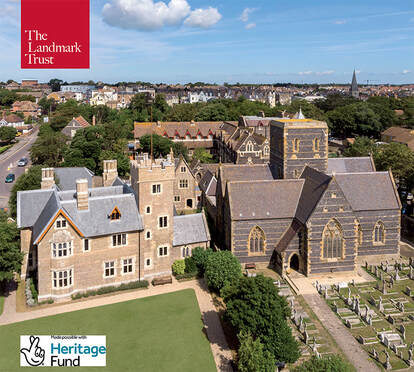
Details announced for the Landmark Trust Open Days at The Grange and St Edward's Presbytery
Details have been announced for this year's Landmark Trust Open Days at The Grange and St Edward's Presbytery in Ramsgate. Events are free but advance booking is required. Open days and times are:
• Friday, 10 June from 12:15-4pm
• Saturday 11 and Sunday 12 June from 10am-4pm
• Monday 13 June from 10am-1pm
Visit landmarktrust.org.uk for further details and download the full PDF flyer HERE.
Details have been announced for this year's Landmark Trust Open Days at The Grange and St Edward's Presbytery in Ramsgate. Events are free but advance booking is required. Open days and times are:
• Friday, 10 June from 12:15-4pm
• Saturday 11 and Sunday 12 June from 10am-4pm
• Monday 13 June from 10am-1pm
Visit landmarktrust.org.uk for further details and download the full PDF flyer HERE.
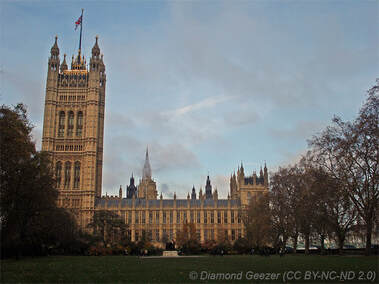
Victoria Tower Gardens Update
The Pugin Society is relieved to hear of the recent High Court decision quashing the proposed erection of a national Holocaust memorial in Victoria Tower Gardens, although this is by no means the end of the story and further problems may still arise. Whilst there is no-one who would not sympathise with the concept of such a memorial in itself, is Victoria Tower Gardens necessarily the best site for it? The London Historic Parks and Gardens Trust, who thought this was ‘the right idea in the wrong place’, took the issue to appeal in opposition to a previous decision supporting the proposal by the Minister of State for Housing and Westminster City Council.
Victoria Tower Gardens is a small, much treasured, gem-like riverside public park, directly adjacent to the south elevation of the Houses of Parliament and with a matchless view of the Victoria Tower, and more. It is very difficult, either visually, or by association, to connect this green space with anything other than the internationally architecturally and politically outstanding work of Pugin and Barry, which dominates it. Samuel Sanders Teulon’s Buxton Memorial Fountain (1865), both stylistically and by virtue of its humanitarian anti-slavery stance and modest scale, fits appropriately into this small site. However, a Holocaust memorial, to be worthy of its purpose, could only be substantial even if, as proposed, partially underground, and would almost certainly cause overcrowding in an already crowded space. Other sites have been suggested – might it not be better to pursue these?
The Pugin Society is relieved to hear of the recent High Court decision quashing the proposed erection of a national Holocaust memorial in Victoria Tower Gardens, although this is by no means the end of the story and further problems may still arise. Whilst there is no-one who would not sympathise with the concept of such a memorial in itself, is Victoria Tower Gardens necessarily the best site for it? The London Historic Parks and Gardens Trust, who thought this was ‘the right idea in the wrong place’, took the issue to appeal in opposition to a previous decision supporting the proposal by the Minister of State for Housing and Westminster City Council.
Victoria Tower Gardens is a small, much treasured, gem-like riverside public park, directly adjacent to the south elevation of the Houses of Parliament and with a matchless view of the Victoria Tower, and more. It is very difficult, either visually, or by association, to connect this green space with anything other than the internationally architecturally and politically outstanding work of Pugin and Barry, which dominates it. Samuel Sanders Teulon’s Buxton Memorial Fountain (1865), both stylistically and by virtue of its humanitarian anti-slavery stance and modest scale, fits appropriately into this small site. However, a Holocaust memorial, to be worthy of its purpose, could only be substantial even if, as proposed, partially underground, and would almost certainly cause overcrowding in an already crowded space. Other sites have been suggested – might it not be better to pursue these?
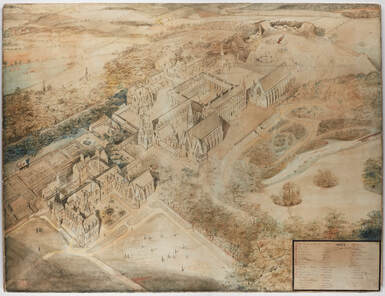
Restoration of H W Brewer's 1858 bird's eye watercolour of St Cuthbert’s College Ushaw co Durham by Rory O'Donnell, December 2021
Ushaw College was the Catholic seminary for the North of England from 1808 to 2011. Access to one of the most important Catholic collections for the whole country is now provided by Ushaw Historic House, Chapel and Gardens. A bird’s eye watercolour drawing of the site as it existed in 1858 has been restored, relined, and reframed by Art Works Conservation, Harrogate, at the coast £2,373. The Decorative Arts Society (London) awarded it an ‘Access’ grant of £1874 and the Pugin Society a grant of £500. Signed in monogram HWB, the artist was identified as Henry W Brewer (1836-1903) by Rory O'Donnell and Grace McCombie (Newcastle) in 2007. (See R O'Donnell ‘EW Pugin’s Junior Seminary at Ushaw (1857-9) and HW Brewer’s bird’s eye view 1858’ in True Principles, Journal of the Pugin Society, vol iii no v (Autumn 2008) pp.32-50).
The enormous watercolour (110 x 143cm) shows top right the original Georgian ranges by James Taylor architect, flanked by the chapel (R) by Pugin and the library (L) by J & C Hansom. These are balanced bottom left by Edward W Pugin‘s Junior seminary (1856-9). A key bottom right identifies the buildings, including AWN Pugin’s chapel (1844-47) - since replaced - from which many furnishings survive. Brewer was one of the many Catholic converts inspired by Pugin and probably in EW Pugin’s office. The precision and intensity of this early work establish Brewer as a master in this specialist mode of architectural presentation, with later examples certainly taken from balloon flights.
Both grant applications were made by Dr Roderick O’Donnell, FSA (London).
Click on the image to enlarge and see all the wonderfully restored detail.
Ushaw College was the Catholic seminary for the North of England from 1808 to 2011. Access to one of the most important Catholic collections for the whole country is now provided by Ushaw Historic House, Chapel and Gardens. A bird’s eye watercolour drawing of the site as it existed in 1858 has been restored, relined, and reframed by Art Works Conservation, Harrogate, at the coast £2,373. The Decorative Arts Society (London) awarded it an ‘Access’ grant of £1874 and the Pugin Society a grant of £500. Signed in monogram HWB, the artist was identified as Henry W Brewer (1836-1903) by Rory O'Donnell and Grace McCombie (Newcastle) in 2007. (See R O'Donnell ‘EW Pugin’s Junior Seminary at Ushaw (1857-9) and HW Brewer’s bird’s eye view 1858’ in True Principles, Journal of the Pugin Society, vol iii no v (Autumn 2008) pp.32-50).
The enormous watercolour (110 x 143cm) shows top right the original Georgian ranges by James Taylor architect, flanked by the chapel (R) by Pugin and the library (L) by J & C Hansom. These are balanced bottom left by Edward W Pugin‘s Junior seminary (1856-9). A key bottom right identifies the buildings, including AWN Pugin’s chapel (1844-47) - since replaced - from which many furnishings survive. Brewer was one of the many Catholic converts inspired by Pugin and probably in EW Pugin’s office. The precision and intensity of this early work establish Brewer as a master in this specialist mode of architectural presentation, with later examples certainly taken from balloon flights.
Both grant applications were made by Dr Roderick O’Donnell, FSA (London).
Click on the image to enlarge and see all the wonderfully restored detail.
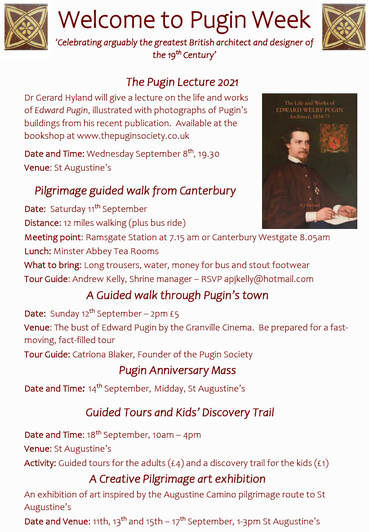
Pugin Week 2021
St Augustine's Church in Ramsgate has a full agenda planned for this year's Pugin Week. Here we highlight events involving society members but we encourage you to take advantage of all events on offer, shown in the image at the right. Click to enlarge or view the PDF HERE.
The Pugin Lecture 2021
Wednesday, 8th September, 7:30pm at St Augustine's Church, Ramsgate, FREE. Dr Gerard Hyland will give a lecture on the life and works of Edward Pugin, illustrated with photographs of Pugin’s buildings from his recent publication, available HERE.
A Guided walk through Pugin’s town
Sunday 12th September – 2pm £5, meet at the bust of Edward Pugin by the Granville Cinema. Catriona Blaker, Founder of the Pugin Society, leads a fast-moving, fact-filled tour of Ramsgate.
St Augustine's Church in Ramsgate has a full agenda planned for this year's Pugin Week. Here we highlight events involving society members but we encourage you to take advantage of all events on offer, shown in the image at the right. Click to enlarge or view the PDF HERE.
The Pugin Lecture 2021
Wednesday, 8th September, 7:30pm at St Augustine's Church, Ramsgate, FREE. Dr Gerard Hyland will give a lecture on the life and works of Edward Pugin, illustrated with photographs of Pugin’s buildings from his recent publication, available HERE.
A Guided walk through Pugin’s town
Sunday 12th September – 2pm £5, meet at the bust of Edward Pugin by the Granville Cinema. Catriona Blaker, Founder of the Pugin Society, leads a fast-moving, fact-filled tour of Ramsgate.
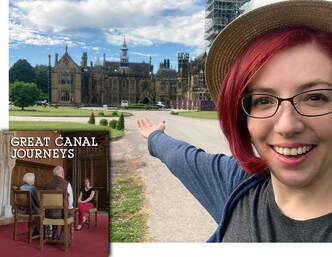
Scarisbrick Hall featured on Great Canal Journeys
Society member Jamie Jacobs spoke with Giles Brandreth and Sheila Hancock during a stop at Scarisbrick Hall on their trip down the Leeds and Liverpool Canal. Jamie states that "it was great fun and an honour to share my expertise with a wider audience to hopefully bring a greater appreciation for Pugin's work." The programme first aired September 1 on Channel 4 and is viewable on demand HERE.
Society member Jamie Jacobs spoke with Giles Brandreth and Sheila Hancock during a stop at Scarisbrick Hall on their trip down the Leeds and Liverpool Canal. Jamie states that "it was great fun and an honour to share my expertise with a wider audience to hopefully bring a greater appreciation for Pugin's work." The programme first aired September 1 on Channel 4 and is viewable on demand HERE.
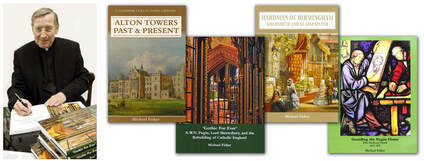
Father Michael Fisher MA, FSA: A Tribute from the Pugin Society
After some time to reflect, the Pugin Society has composed an obituary honoring the life and works of Fr Michael Fisher which can be read HERE.
After some time to reflect, the Pugin Society has composed an obituary honoring the life and works of Fr Michael Fisher which can be read HERE.
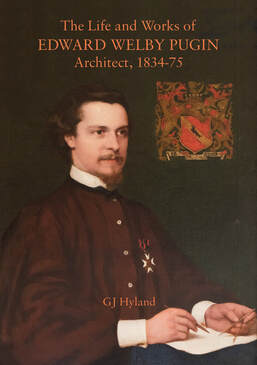
New Pugin Society publication by Gerard Hyland - The Life and Works of Edward Welby Pugin now available for purchase in the Bookshop
The Pugin Society is pleased to announce the publication of Gerard Hyland's updated and expanded gazetteer charting EW Pugin's works. The book is a companion to The Architectural Works of AWN Pugin, by the same author, published by Spire Books in 2014. Visit our BOOKSHOP to purchase a copy of the publication.
Despite the growth in Pugin Studies during the past 40 years, no comprehensive catalogue of the architectural works of Edward Welby Pugin (AWN Pugin’s eldest son) has ever been published, an omission that this book - in the form of a Catalogue Raisonné - rectifies, in the hope that it will secure his reputation as one of the most eminent and prolific High Victorian Catholic architects of the English Gothic Revival.
This major study identifies 287 executed works, spread over six countries, whose EW Pugin provenance is established beyond doubt; he alone was responsible for the vast majority of this work, the remainder originating from a few architectural partnerships, the most productive being that with the Irishman GC Ashlin. The corpus of work is organised into 8 categories, each of which is prefaced by a generously illustrated critical analysis that highlights specific points of architectural interest and identifies stylistic interconnections within the wider EW Pugin canon; also included are details of 94 commissions that are known definitely never to have been realised. In addition, there are seven Appendices containing background information, including details of his various architectural partnerships and a useful summary of the totality of his realised buildings in the form of a gazetteer arranged by county, according to country.
The majority of the realised work is ecclesiastical or related, mainly, but not exclusively, for the Catholic Church, and comprises places of worship, convents & monasteries, presbyteries & houses for religious communities, colleges & schools (the majority of the latter being associated with parish churches designed by EW Pugin), institutional buildings (such as orphanages & almshouses), and many minor works, including designs for altars and funerary monuments. The secular work comprises both residential and commercial buildings, as well as additions to/remodelling of houses by other architects. A well-referenced biographical sketch of EW Pugin, based on the fragmentary information available to date, provides a socio-historical perspective to his work.
The Pugin Society is pleased to announce the publication of Gerard Hyland's updated and expanded gazetteer charting EW Pugin's works. The book is a companion to The Architectural Works of AWN Pugin, by the same author, published by Spire Books in 2014. Visit our BOOKSHOP to purchase a copy of the publication.
Despite the growth in Pugin Studies during the past 40 years, no comprehensive catalogue of the architectural works of Edward Welby Pugin (AWN Pugin’s eldest son) has ever been published, an omission that this book - in the form of a Catalogue Raisonné - rectifies, in the hope that it will secure his reputation as one of the most eminent and prolific High Victorian Catholic architects of the English Gothic Revival.
This major study identifies 287 executed works, spread over six countries, whose EW Pugin provenance is established beyond doubt; he alone was responsible for the vast majority of this work, the remainder originating from a few architectural partnerships, the most productive being that with the Irishman GC Ashlin. The corpus of work is organised into 8 categories, each of which is prefaced by a generously illustrated critical analysis that highlights specific points of architectural interest and identifies stylistic interconnections within the wider EW Pugin canon; also included are details of 94 commissions that are known definitely never to have been realised. In addition, there are seven Appendices containing background information, including details of his various architectural partnerships and a useful summary of the totality of his realised buildings in the form of a gazetteer arranged by county, according to country.
The majority of the realised work is ecclesiastical or related, mainly, but not exclusively, for the Catholic Church, and comprises places of worship, convents & monasteries, presbyteries & houses for religious communities, colleges & schools (the majority of the latter being associated with parish churches designed by EW Pugin), institutional buildings (such as orphanages & almshouses), and many minor works, including designs for altars and funerary monuments. The secular work comprises both residential and commercial buildings, as well as additions to/remodelling of houses by other architects. A well-referenced biographical sketch of EW Pugin, based on the fragmentary information available to date, provides a socio-historical perspective to his work.
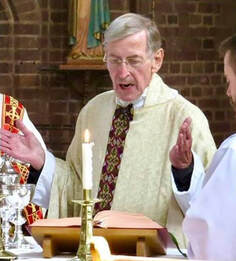
Passing of Fr Michael Fisher, 1943-2021
We are sorry to have learnt of the passing of Fr Michael Fisher, MA FSA who died peacefully on the evening of Monday, 19 April. He was an exemplary priest, an erudite scholar, and a gentleman whose contribution to Pugin Studies cannot be overestimated – he will be sorely missed.
He was an active member of the Society and facilitated and led many of our tours in Staffordshire including tours at Alton Towers.
Our thoughts are with Isobel his wife and Sarah his daughter and the rest of the family. An obituary written on behalf the Society will follow in due course.
Requiem aeternam dona ei, Domine, et lux perpetua luceat ei.
His funeral will be at St Chad's, Stafford, Wednesday (28 April 2021) at 11.00am. It will be live streamed on facebook HERE.
We are sorry to have learnt of the passing of Fr Michael Fisher, MA FSA who died peacefully on the evening of Monday, 19 April. He was an exemplary priest, an erudite scholar, and a gentleman whose contribution to Pugin Studies cannot be overestimated – he will be sorely missed.
He was an active member of the Society and facilitated and led many of our tours in Staffordshire including tours at Alton Towers.
Our thoughts are with Isobel his wife and Sarah his daughter and the rest of the family. An obituary written on behalf the Society will follow in due course.
Requiem aeternam dona ei, Domine, et lux perpetua luceat ei.
His funeral will be at St Chad's, Stafford, Wednesday (28 April 2021) at 11.00am. It will be live streamed on facebook HERE.
 Photo by Alejandro Escamilla on Unsplash
Photo by Alejandro Escamilla on Unsplash
21 April, 6pm: What happened next to Pugin's 'Realism'? - online lecture by Dr Timothy Brittain-Catlin
The Pugin Society is pleased to announce the fourth of our online lectures, where Dr Timothy Brittain-Catlin will discuss Pugin's interpretation of and contribution to the architectural concept of realism. Visit our EVENTS page for details.
The Pugin Society is pleased to announce the fourth of our online lectures, where Dr Timothy Brittain-Catlin will discuss Pugin's interpretation of and contribution to the architectural concept of realism. Visit our EVENTS page for details.
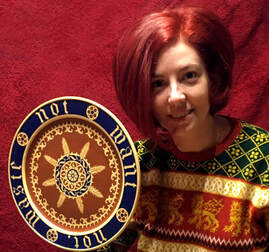
'Why I had to study Pugin' by Joanna Lyall, December 2020
“When I first saw St Chad’s that was it. I knew I had to study Pugin,” says Jamie Jacobs who completed her PhD this autumn. Originally from Spring Valley, Illinois, a small town south west of Chicago, Jamie was in Birmingham in 2007 for the funeral of her partner’s grandmother and took the opportunity of touring the Pugin sites and Hardman’s workshop before spending a week in London to visit the Victoria and Albert Museum and the Palace of Westminster.
She then decided to move to England and start her research for a PhD on Principles and Practice: Craft and Mechanisation in the Fabrication of A.W.N. Pugin’s Designs in the Applied Arts at the University of Kent, under the supervision of Tim Brittain-Catlin, then reader in architecture, and former editor of True Principles. The topic of Tim’s PhD was Pugin’s domestic architecture in England.
“I was living in Chicago at the time but it was obvious I needed to be in England for the research and the idea of being so near The Grange, in Ramsgate, also appealed,” she says.
Jamie has a BA in English from Northern Illinois University and a BA in Art from De Paul University, Chicago. She then studied for an MA in Art History from Northern Illinois University, focusing on Pugin and industrialisation.
“A lecturer showed us an image of Pugin’s Glastonbury chair and I became fascinated. I have always wanted to know how things are made, and the ideas behind them,’ she says. A chapter by the late Clive Wainwright A.W.N. Pugin and the Progress of Design as Applied to Manufacture in the catalogue for the 1995 Pugin exhibition at the Bard Graduate Center, New York, also aroused her interest.
The research was made very much easier by the publication of Pugin’s letters, edited by the late Margaret Belcher, and published in five volumes between 2001 and 2015, she says.
A member of the Pugin Society for many years, Jamie redesigned its website which she now manages. In 2018 she gave a paper at the British Association of Victorian Studies conference on Pugin’s work at the Houses of Parliament. In October last year she spoke on Pugin and Hardman’s metalwork in the Palace of Westminster, at a symposium organised by the Pugin Society.
And a bequest from an aunt allowed Jamie to buy her own piece of Pugin – A Waste Not Want Not plate, which she treasures.
Before starting her PhD Jamie taught at the Art Institute of Chicago and now hopes to return to the classroom. While studying at Kent she earned an associate fellowship of the Higher Education Academy.
Jamie will be giving a webinar by zoom on the subject of her PhD to Pugin Society members in February.
“When I first saw St Chad’s that was it. I knew I had to study Pugin,” says Jamie Jacobs who completed her PhD this autumn. Originally from Spring Valley, Illinois, a small town south west of Chicago, Jamie was in Birmingham in 2007 for the funeral of her partner’s grandmother and took the opportunity of touring the Pugin sites and Hardman’s workshop before spending a week in London to visit the Victoria and Albert Museum and the Palace of Westminster.
She then decided to move to England and start her research for a PhD on Principles and Practice: Craft and Mechanisation in the Fabrication of A.W.N. Pugin’s Designs in the Applied Arts at the University of Kent, under the supervision of Tim Brittain-Catlin, then reader in architecture, and former editor of True Principles. The topic of Tim’s PhD was Pugin’s domestic architecture in England.
“I was living in Chicago at the time but it was obvious I needed to be in England for the research and the idea of being so near The Grange, in Ramsgate, also appealed,” she says.
Jamie has a BA in English from Northern Illinois University and a BA in Art from De Paul University, Chicago. She then studied for an MA in Art History from Northern Illinois University, focusing on Pugin and industrialisation.
“A lecturer showed us an image of Pugin’s Glastonbury chair and I became fascinated. I have always wanted to know how things are made, and the ideas behind them,’ she says. A chapter by the late Clive Wainwright A.W.N. Pugin and the Progress of Design as Applied to Manufacture in the catalogue for the 1995 Pugin exhibition at the Bard Graduate Center, New York, also aroused her interest.
The research was made very much easier by the publication of Pugin’s letters, edited by the late Margaret Belcher, and published in five volumes between 2001 and 2015, she says.
A member of the Pugin Society for many years, Jamie redesigned its website which she now manages. In 2018 she gave a paper at the British Association of Victorian Studies conference on Pugin’s work at the Houses of Parliament. In October last year she spoke on Pugin and Hardman’s metalwork in the Palace of Westminster, at a symposium organised by the Pugin Society.
And a bequest from an aunt allowed Jamie to buy her own piece of Pugin – A Waste Not Want Not plate, which she treasures.
Before starting her PhD Jamie taught at the Art Institute of Chicago and now hopes to return to the classroom. While studying at Kent she earned an associate fellowship of the Higher Education Academy.
Jamie will be giving a webinar by zoom on the subject of her PhD to Pugin Society members in February.
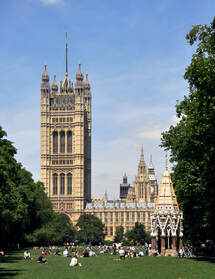
Discussion on the Future of Victoria Tower Gardens
In light of the proposal to reallocate the use of Victoria Tower Gardens, Dorian Gerhold presented a talk about the history of this space to The Thorney Island Society which can be viewed HERE. A small expanse of land between the Houses of Parliament, the River Thames, Millbank and Lambeth Bridge, the garden comprises part of the Parliamentary estate and is partly within the UNESCO World Heritage Site of Westminster. We thought Society members would be interested in learning about the history of the gardens and the debate concerning its future development. While we are happy to share this excellent lecture, the views presented are those of Dr Gerhold and the Thorney Island Society.
In light of the proposal to reallocate the use of Victoria Tower Gardens, Dorian Gerhold presented a talk about the history of this space to The Thorney Island Society which can be viewed HERE. A small expanse of land between the Houses of Parliament, the River Thames, Millbank and Lambeth Bridge, the garden comprises part of the Parliamentary estate and is partly within the UNESCO World Heritage Site of Westminster. We thought Society members would be interested in learning about the history of the gardens and the debate concerning its future development. While we are happy to share this excellent lecture, the views presented are those of Dr Gerhold and the Thorney Island Society.

The Pugin Society presents its first free online lecture
The Pugin Society is pleased to announce the first of a series of online lectures on topics relating to AWN Pugin and the Pugin family. The first of these will be 9 December by the author and historian Rosemary Hill. Visit our EVENTS page for more details.
The Pugin Society is pleased to announce the first of a series of online lectures on topics relating to AWN Pugin and the Pugin family. The first of these will be 9 December by the author and historian Rosemary Hill. Visit our EVENTS page for more details.
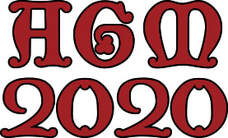
This year’s AGM will be held online via Zoom on Saturday 12th December at 11 o’clock.
We will not be able to have the traditional format of the AGM followed by the annual lecture. So that we can make the meeting run smoothly we will be producing an annual report in advance of the meeting that will be circulated to members in advance. This will allow for any questions to be submitted in advance of the meeting so that the officers can answer on the day. For this year it will not be possible to raise issues on the day. We will ask you to register for the meeting and you will then be sent the link via email to join.
At this year’s meeting Joanna Lyall will be standing down after 10 years as Honorary Secretary. The committee would like to thank Joanna for her outstanding contribution to the running of the Society and to its on-going development that she has supported over the last 10 years.
Since the start of the pandemic the committee has continued to meet, and we are all becoming more familiar with Zoom as a format for the meetings. As part of our change to the digital world members are now familiar with the e-newsletter that John Elliott has developed. We know members will be disappointed that there will not be a lecture as part of the AGM so our next development has been to purchase a Zoom subscription for Webinars. This will allow us to host on-line lectures. Our events co-ordinator Julia Twigg is currently working on the lecture programme.
We will not be able to have the traditional format of the AGM followed by the annual lecture. So that we can make the meeting run smoothly we will be producing an annual report in advance of the meeting that will be circulated to members in advance. This will allow for any questions to be submitted in advance of the meeting so that the officers can answer on the day. For this year it will not be possible to raise issues on the day. We will ask you to register for the meeting and you will then be sent the link via email to join.
At this year’s meeting Joanna Lyall will be standing down after 10 years as Honorary Secretary. The committee would like to thank Joanna for her outstanding contribution to the running of the Society and to its on-going development that she has supported over the last 10 years.
Since the start of the pandemic the committee has continued to meet, and we are all becoming more familiar with Zoom as a format for the meetings. As part of our change to the digital world members are now familiar with the e-newsletter that John Elliott has developed. We know members will be disappointed that there will not be a lecture as part of the AGM so our next development has been to purchase a Zoom subscription for Webinars. This will allow us to host on-line lectures. Our events co-ordinator Julia Twigg is currently working on the lecture programme.
Theory of Architecture podcast featuring Pugin author Rosemary Hill
|
Rosemary Hill, the writer, historian, independent scholar and author of 'God’s Architect', a biography of the Gothic Revival architect, A.W.N. Pugin and 'Stonehenge', a history of one of Britain’s greatest and least understood monuments, has shared this episode of architect Bruce Buckland's podcast Theory of Architecture. In this episode she covers Pugin, Stonehenge and clothes.
|
|
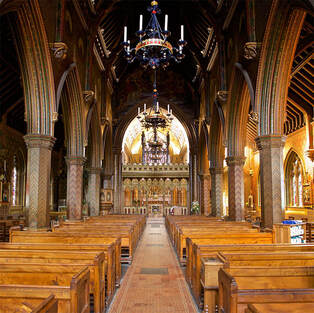
The power of Pugin. How St Giles Cheadle nudged former Times religious affairs correspondent towards conversion by Joanna Lyall, April 19, 2020
Ruth Gledhill, who worked as The Times’ religious affairs correspondent for 27 years has described how St Giles Cheadle played a key role on her road to Catholicism.
Writing in the Easter issue of The Tablet, where she is now digital editor, Gledhill recalls visiting the Augustus Pugin church, with her father, Peter, an Anglican clergyman, at the age of ten and finding it “almost too beautiful to describe”.
She was left alone in the Blessed Sacrament chapel, “in the chair in which John Henry Newman is thought to have sat when he visited the church after his conversion (“This is the gate of heaven,” he whispered on setting eyes on the sumptuous interior).
“For an hour I gazed transfixed at the tabernacle resting on the alabaster altar, amid the encircling red and gold Minton tiles of Pugin’s extraordinary Gothic revival creation.
“That brief moment of divine sensory overload was the starting point of a journey that, after some meandering, and much spiritual seeking, has at last led to my own reception into the Catholic Church,” she wrote.
Gledhill, now 60, describes how the family ended up living in Staffordshire, where her father was working as an RE teacher at a school in Cheadle, following a period in Barbados where he had been diagnosed with schizophrenia, suffered a breakdown and made a suicide attempt. He later accepted a Church of England parish outside Uttoxeter, but life continued difficult for the family which by then included five children.
“I don’t blame my father or his mental health issues for my own alcoholism, or my brother Owen’s suicide at a young age,” she writes. “But the permanent feeling of hunger, and a terrible thirst, spiritual as well as physical, that almost nothing seemed to slake, probably had their roots in these traumatic experiences from my early childhood.”
At the age of 25, when working at The Daily Mail, before joining The Times, she admitted to alcoholism and has been sober since. And she never forgot the feeling of peace experienced at St Giles.
Due to be received into the Catholic Church last September Gledhill ended up in hospital for three weeks suffering from severe acute gallstone pancreatitis and while there had a near death experience. “I have no doubt I would have become a Catholic anyway, but this experience quickened my resolve. Now I was sure.”
“One of the first things I did after my conversion was to re-visit that Blessed Sacrament Chapel in St Giles’, and sit in that same chair and pray quietly,” she writes.
“As a deeply flawed person, needing forgiveness and seeking compassion, I am at home in an institution that is itself deeply flawed and yearning for mercy. And that is what it feels like. Coming home”. https://www.stgilescheadle.org.uk
Ruth Gledhill, who worked as The Times’ religious affairs correspondent for 27 years has described how St Giles Cheadle played a key role on her road to Catholicism.
Writing in the Easter issue of The Tablet, where she is now digital editor, Gledhill recalls visiting the Augustus Pugin church, with her father, Peter, an Anglican clergyman, at the age of ten and finding it “almost too beautiful to describe”.
She was left alone in the Blessed Sacrament chapel, “in the chair in which John Henry Newman is thought to have sat when he visited the church after his conversion (“This is the gate of heaven,” he whispered on setting eyes on the sumptuous interior).
“For an hour I gazed transfixed at the tabernacle resting on the alabaster altar, amid the encircling red and gold Minton tiles of Pugin’s extraordinary Gothic revival creation.
“That brief moment of divine sensory overload was the starting point of a journey that, after some meandering, and much spiritual seeking, has at last led to my own reception into the Catholic Church,” she wrote.
Gledhill, now 60, describes how the family ended up living in Staffordshire, where her father was working as an RE teacher at a school in Cheadle, following a period in Barbados where he had been diagnosed with schizophrenia, suffered a breakdown and made a suicide attempt. He later accepted a Church of England parish outside Uttoxeter, but life continued difficult for the family which by then included five children.
“I don’t blame my father or his mental health issues for my own alcoholism, or my brother Owen’s suicide at a young age,” she writes. “But the permanent feeling of hunger, and a terrible thirst, spiritual as well as physical, that almost nothing seemed to slake, probably had their roots in these traumatic experiences from my early childhood.”
At the age of 25, when working at The Daily Mail, before joining The Times, she admitted to alcoholism and has been sober since. And she never forgot the feeling of peace experienced at St Giles.
Due to be received into the Catholic Church last September Gledhill ended up in hospital for three weeks suffering from severe acute gallstone pancreatitis and while there had a near death experience. “I have no doubt I would have become a Catholic anyway, but this experience quickened my resolve. Now I was sure.”
“One of the first things I did after my conversion was to re-visit that Blessed Sacrament Chapel in St Giles’, and sit in that same chair and pray quietly,” she writes.
“As a deeply flawed person, needing forgiveness and seeking compassion, I am at home in an institution that is itself deeply flawed and yearning for mercy. And that is what it feels like. Coming home”. https://www.stgilescheadle.org.uk


























